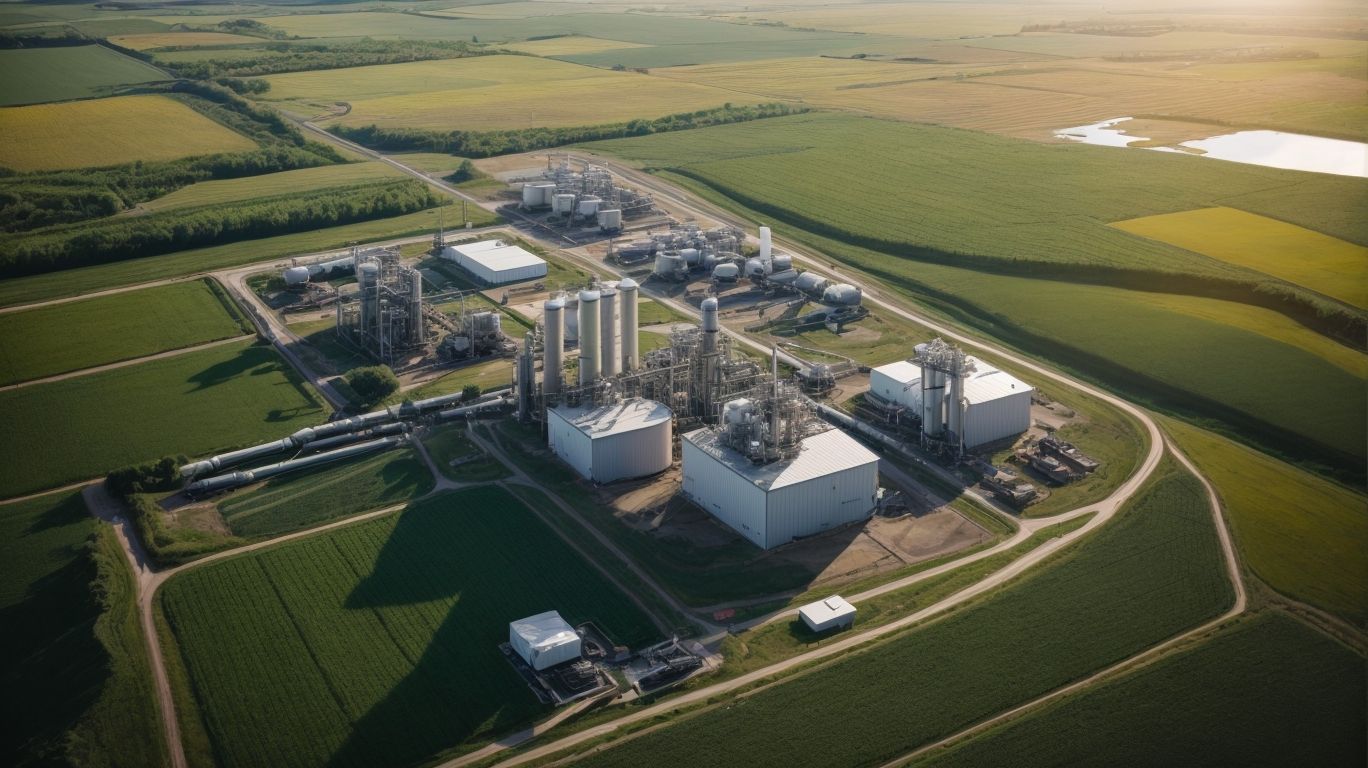Ethanol, also known as ethyl alcohol, is a colorless and volatile liquid that is widely used as a fuel source. It is produced through the fermentation of various plant-based materials, such as corn, sugar cane, and wheat.
The combustion of ethanol is a complex chemical process that involves the release of heat and energy. In this article, we will dive into the science behind ethanol combustion and its various applications.
Ethanol has a molecular formula of C2H6O and is highly flammable. It is soluble in water and has a low boiling point, making it a suitable fuel for engines. When ethanol is burned, it undergoes a chemical reaction with oxygen in the air, producing carbon dioxide, water, and heat. This reaction is known as combustion and results in the release of energy that can be used for various purposes.
The combustion of ethanol can be broken down into three main steps:
- Understanding the Chemical Reaction: The chemical equation for ethanol combustion is C2H6O + 3O2 → 2CO2 + 3H2O. This equation shows that for every molecule of ethanol, three molecules of oxygen are required for complete combustion.
- Heat Release and Energy Conversion: The heat released during ethanol combustion is used to power engines and produce energy. This heat is converted into mechanical energy, which is then converted into other forms such as electricity.
- Products of Combustion: As mentioned earlier, the products of ethanol combustion are carbon dioxide and water. However, in certain conditions, incomplete combustion can occur, resulting in the production of harmful by-products such as carbon monoxide and soot.
There are different types of ethanol combustion, including:
- Complete Combustion: This occurs when there is a sufficient amount of oxygen present, resulting in the production of only carbon dioxide and water.
- Incomplete Combustion: In this type of combustion, there is a lack of oxygen, leading to the production of toxic by-products such as carbon monoxide and soot.
- Stoichiometric Combustion: This is when the perfect amount of oxygen is present for complete combustion to occur, resulting in the ideal ratio of carbon dioxide and water.
Ethanol has various applications, including:
- Fuel for Vehicles: Ethanol is commonly used as a fuel in vehicles, either on its own or in a blend with gasoline. Its use as a fuel source can help reduce greenhouse gas emissions and dependence on fossil fuels.
- Heating and Cooking: Ethanol can also be used for heating and cooking purposes, particularly in areas where other fuel sources are not readily available.
- Industrial Uses: Ethanol is used in the production of various products, such as hand sanitizers, perfumes, and pharmaceuticals.
The combustion of ethanol has both positive and negative environmental impacts. On one hand, it can reduce greenhouse gas emissions and dependence on fossil fuels. On the other hand, the production of ethanol can contribute to air pollution and deforestation for land use.
When handling ethanol, it is important to take safety precautions. It is a highly flammable substance, and proper ventilation is necessary to prevent the buildup of vapors. It is also important to avoid skin contact and to handle it with care to prevent spills and accidents.
In conclusion, the science behind ethanol combustion is an important topic to understand, given the widespread use of ethanol as a fuel source. By understanding the chemical reaction and various types of combustion, we can better appreciate its applications and the potential environmental impacts. Proper safety precautions should also be taken when handling ethanol to ensure its safe use.
Key Takeaways:
What Is Ethanol?

Photo Credits: Chemicalglossary.Net by Elijah Hill
Ethanol is a type of alcohol commonly used as a fuel source. It is created through the fermentation of sugars, typically from crops such as corn or sugarcane. This clear, colorless liquid has a distinct odor and is highly flammable, making it suitable for use as a solvent or antiseptic. Along with its role as a fuel, ethanol is also present in alcoholic beverages. It is important to handle ethanol with caution due to its flammability.
Pro-tip: Ethanol can also serve as a cleaner or disinfectant thanks to its antiseptic properties.
What Are the Properties of Ethanol?

Photo Credits: Chemicalglossary.Net by Joshua Lopez
What Are the Properties of Ethanol?
Ethanol, also known as ethyl alcohol or grain alcohol, is a clear, colorless liquid with a distinctive, mildly sweet odor. It is highly flammable and evaporates rapidly at room temperature. With a boiling point of 78.37°C and a freezing point of -114.14°C, it has a wide range of temperatures in which it can exist. Being miscible in water, it can mix with water in any proportion. Due to its polar nature, ethanol is an effective solvent for many substances. It has a variety of uses, including as a fuel, in alcoholic beverages, and as an ingredient in products such as hand sanitizers and cleaning agents.
How Does Ethanol Combustion Work?

Photo Credits: Chemicalglossary.Net by Brandon Allen
Ethanol combustion is a fascinating chemical process that involves the reaction of ethanol (a type of alcohol) with oxygen to produce heat and energy. In this section, we will delve into the inner workings of this reaction, exploring the chemical reactions that take place and how they result in the release of heat and energy. We will also examine the various products that are formed during ethanol combustion, shedding light on the science behind this essential process. Get ready to dive into the fascinating world of ethanol combustion and uncover the secrets behind this powerful reaction.
Understanding the Chemical Reaction
To gain a deeper understanding of the chemical reaction involved in ethanol combustion, it is necessary to examine the process in detail. Ethanol, a type of alcohol, undergoes combustion when it reacts with oxygen in the presence of heat or a spark. This reaction results in the production of carbon dioxide, water vapor, and heat energy. The balanced chemical equation for ethanol combustion is C2H5OH + 3O2 → 2CO2 + 3H2O + heat. This exothermic reaction releases a significant amount of heat, making ethanol a valuable source of energy. Having a thorough understanding of the chemical reaction of ethanol combustion is crucial for various applications, such as fuel for vehicles and heating systems.
Fun Fact: Ethanol has been used as a fuel since ancient times, with the first recorded use dating back to the Roman Empire.
Heat Release and Energy Conversion
Heat release and energy conversion are crucial elements of ethanol combustion. Here is a step-by-step breakdown of the process:
- Ignition: The ethanol vapor is ignited, typically through a spark or flame.
- Heat Release: The combustion reaction transforms the stored chemical energy in ethanol into heat energy.
- Energy Conversion: The heat energy is then converted into other forms, such as mechanical energy in an engine or thermal energy for heating.
- Expansion: As the ethanol burns, the released heat causes the surrounding air or gases to expand.
- Work Production: In engines, this expansion of gases generates pressure, which produces useful work.
True story: In a remote village, ethanol combustion is utilized to power a small generator. The heat released from burning ethanol generates electricity, providing a reliable source of power for the community’s basic needs, such as lighting and refrigeration. This sustainable energy solution has improved the villagers’ quality of life and reduced their dependence on fossil fuels.
Products of Combustion
During ethanol combustion, a variety of products are produced as a result of the chemical reaction. These products include carbon dioxide (CO2), water vapor (H2O), and heat. The process of combustion involves the oxidation of ethanol, which releases energy in the form of heat. Through this reaction, the carbon and hydrogen atoms in ethanol combine with oxygen from the air to form CO2 and H2O. This reaction is considered exothermic, meaning it releases heat energy. Understanding the products of combustion is crucial in assessing the efficiency and environmental impact of ethanol as a fuel source.
What Are the Different Types of Ethanol Combustion?

Photo Credits: Chemicalglossary.Net by Juan Wilson
When it comes to ethanol combustion, there are various types of reactions that can occur. Each type has its own unique characteristics and outcomes. In this section, we will delve into the different types of ethanol combustion and how they differ from one another. From complete and incomplete combustion to the more precise stoichiometric combustion, we will explore the science behind each reaction and how they contribute to the overall process. Let’s dive in and uncover the complexities of ethanol combustion.
Complete Combustion
Complete combustion is a type of ethanol combustion that occurs when ethanol reacts with oxygen to produce carbon dioxide and water. Here are the steps involved in the process of complete combustion:
- Supply ethanol and oxygen: Ethanol is mixed with an adequate supply of oxygen for the reaction to take place.
- Ignition: The mixture is ignited, providing the necessary activation energy.
- Reaction: Ethanol molecules break apart, and carbon, hydrogen, and oxygen atoms combine with oxygen molecules to form carbon dioxide and water.
- Heat release: The reaction releases heat energy, which is utilized for various applications such as heating, cooking, and powering vehicles.
- Complete products: The end result of complete combustion is carbon dioxide and water, with no other byproducts or pollutants.
Complete combustion is the preferred process as it produces cleaner and more efficient energy compared to incomplete combustion.
Incomplete Combustion
Incomplete combustion is a type of ethanol combustion that occurs when there is a limited supply of oxygen. Instead of completely reacting with oxygen, ethanol forms incomplete products such as carbon monoxide and soot. This process is less efficient and produces less energy compared to complete combustion. It also releases harmful pollutants, including toxic carbon monoxide, into the atmosphere.
To prevent the risks associated with incomplete combustion, it is crucial to have proper ventilation and combustion conditions.
Stoichiometric Combustion
Stoichiometric combustion, also referred to as chemically balanced combustion, is a specific type of ethanol combustion that requires a perfect balance of fuel and oxygen for complete oxidation. Through this process, the ideal amount of air reacts with ethanol to produce carbon dioxide and water as the main byproducts, resulting in efficient energy release and minimal formation of pollutants.
This technique is commonly utilized in automotive engines to maximize fuel efficiency and decrease harmful emissions. It is important to understand and optimize stoichiometric combustion in order to develop cleaner and more effective ethanol-based fuels.
What Are the Applications of Ethanol Combustion?

Photo Credits: Chemicalglossary.Net by Brian Walker
Ethanol combustion is a chemical reaction that has a wide range of practical applications. In this section, we will explore the various ways in which this reaction is utilized in different industries and everyday activities. From powering vehicles to heating homes and cooking food, the versatility of ethanol combustion makes it an essential component in our modern society. Additionally, we will also delve into its industrial uses and how it plays a crucial role in various manufacturing processes. Join us as we uncover the many applications of ethanol combustion and gain a deeper understanding of its importance in our daily lives.
Fuel for Vehicles
Fuel for vehicles is one of the key applications of ethanol combustion. Ethanol, a renewable biofuel, can be used as a substitute for gasoline in cars and other vehicles. It is commonly blended with gasoline to create a fuel known as E10, which consists of 10% ethanol and 90% gasoline. Flex-fuel vehicles are designed to run on E85, a blend of 85% ethanol and 15% gasoline. Ethanol as a fuel for vehicles helps reduce greenhouse gas emissions, decrease dependence on fossil fuels, and promote sustainable transportation.
In fact, as early as 1908, Henry Ford’s Model T was designed to run on ethanol, showcasing the potential of this fuel for vehicles. However, with the advancements in petroleum-based fuels and the discovery of vast oil reserves, the focus shifted away from ethanol until recent years when renewable energy and sustainability have become important considerations in transportation.
Heating and Cooking
When it comes to heating and cooking, ethanol combustion can be a useful option. Here are some steps to consider:
- Check for proper ventilation in the cooking area to ensure the safe release of combustion byproducts.
- Use the appropriate equipment, such as ethanol-fueled stoves or grills, designed specifically for ethanol combustion.
- Make sure to follow the manufacturer’s instructions for safe handling and storage of ethanol fuel.
- When using ethanol for cooking, be aware of its high flammability and take necessary precautions, such as keeping a fire extinguisher nearby.
- Ensure that the ethanol fuel is stored in a secure and well-ventilated location, away from any potential sources of ignition.
By following these steps, you can safely utilize ethanol combustion for heating and cooking purposes.
Industrial Uses
The industrial uses of ethanol are vast and extensive. This versatile substance is often used as a solvent in industries such as pharmaceuticals, cosmetics, and paints. In the automotive industry, it is commonly added to fuels to improve octane ratings and reduce emissions. Ethanol is also a key ingredient in the production of various chemicals, including ethylene and acetic acid. Its applications extend to the manufacturing of personal care products, cleaning agents, and disinfectants. With its versatility and environmentally friendly properties, ethanol is a valuable resource in numerous industrial processes.
What Are the Environmental Impacts of Ethanol Combustion?

Photo Credits: Chemicalglossary.Net by Jacob Flores
As a widely used fuel source, it is important to understand the environmental impacts of ethanol combustion. In this section, we will delve into the science behind the reaction process and how it contributes to various environmental concerns. We will explore the effects of ethanol combustion on greenhouse gas emissions, air pollution levels, and land use and deforestation. By examining these factors, we can gain a better understanding of the overall impact of ethanol combustion on our planet.
Greenhouse Gas Emissions
Ethanol combustion raises concerns about greenhouse gas emissions. Although ethanol is a renewable fuel derived from plant material, such as corn or sugarcane, its production and combustion still contribute to the release of greenhouse gases. The cultivation of crops for ethanol production often involves land use, which can result in deforestation and the release of stored carbon. Furthermore, the combustion of ethanol releases carbon dioxide into the atmosphere. Therefore, while there may be benefits to using ethanol as a fuel, it is crucial to address and reduce its environmental impact, specifically its contribution to greenhouse gas emissions.
Air Pollution
The combustion of ethanol is a major contributor to air pollution, as it releases harmful pollutants into the atmosphere. When ethanol is burned, it emits carbon dioxide (CO2), a greenhouse gas that contributes to the growing issue of climate change. Incomplete combustion of ethanol can also result in the release of carbon monoxide (CO), a toxic gas. The combustion process also produces nitrogen oxides (NOx) and volatile organic compounds (VOCs), which contribute to the formation of smog and respiratory problems.
To combat air pollution caused by ethanol combustion, it is crucial to use cleaner burning fuels, such as ethanol blends with lower levels of pollutants, and to implement technologies that reduce emissions from vehicles and industrial processes.
Land Use and Deforestation
Land use and deforestation are major environmental consequences of using ethanol as a fuel. The production of ethanol demands large areas of land for growing crops like corn or sugarcane, which can result in deforestation when forests are cleared for agricultural purposes. This conversion of land disrupts ecosystems, destroys habitats, and diminishes biodiversity. Additionally, the intensive cultivation of crops may involve the use of pesticides and fertilizers, which can exacerbate environmental degradation. It is essential to take into account the effects on land use and deforestation when evaluating the sustainability of ethanol as a source of fuel.
What Are the Safety Precautions for Handling Ethanol?

Photo Credits: Chemicalglossary.Net by Ronald Anderson
When working with ethanol, it is crucial to take proper safety precautions to ensure personal well-being and prevent accidents. Here are some essential safety measures to follow:
- Proper ventilation: It is important to work in a well-ventilated area or use a fume hood to minimize the risk of inhaling ethanol vapors.
- Fire safety: Due to its highly flammable nature, it is important to keep ethanol away from open flames, sparks, or heat sources. It is recommended to use fire-resistant containers and have fire extinguishers nearby.
- Personal protective equipment: To protect your skin and eyes from direct contact with ethanol, it is important to wear appropriate protective gear such as gloves, safety goggles, and a lab coat.
- Storage: Ethanol should be stored in a cool, dry place, away from any incompatible substances. It is important to use approved storage containers and ensure proper labeling.
- Handling: When transferring ethanol, it is important to use suitable containers and avoid splashing or spilling. It is recommended to pour slowly and carefully.
Remember, understanding and implementing safety precautions is crucial for the safe handling and storage of ethanol.
Frequently Asked Questions
1. What are some important safety precautions to consider when performing the alcohol gun experiment?
It is important to wear proper eye protection and have safety screens set up to protect both the teacher and students. The class should also be seated at a safe distance. It is recommended to use only ethanol (IDA) as the fuel and to read standard health and safety guidance before conducting the experiment.
2. Can any other alcohol besides ethanol be used in the alcohol gun experiment?
No, it is not safe to use any other alcohol besides ethanol (IDA) in the alcohol gun experiment. Ethanol is the only recommended chemical to use and using any other alcohol can be dangerous.
3. How long does it take to perform the alcohol gun experiment?
The alcohol gun experiment only takes about five minutes to perform, making it a quick and easy demonstration to incorporate into a lesson plan.
4. What is the purpose of using a plastic fizzy drinks bottle in the alcohol gun experiment?
A plastic fizzy drinks bottle is used because it can withstand pressures up to 20 atmospheres. This is necessary for the minor explosion that occurs during the experiment.
5. How is the spark generator in the alcohol gun experiment completed?
The spark generator can be completed by connecting an EHT power pack or modified piezoelectric lighter to the terminal block. The spark gap must be adjusted to about 5 kV for reliable firing.
6. What is the importance of balancing the equation for the combustion of ethanol?
Balancing the equation for the combustion of ethanol is important because it shows the reactants (ethanol and oxygen) and products (carbon dioxide and water) involved in the reaction. This equation also helps to understand the amount of heat energy released during the high temperature reaction.
